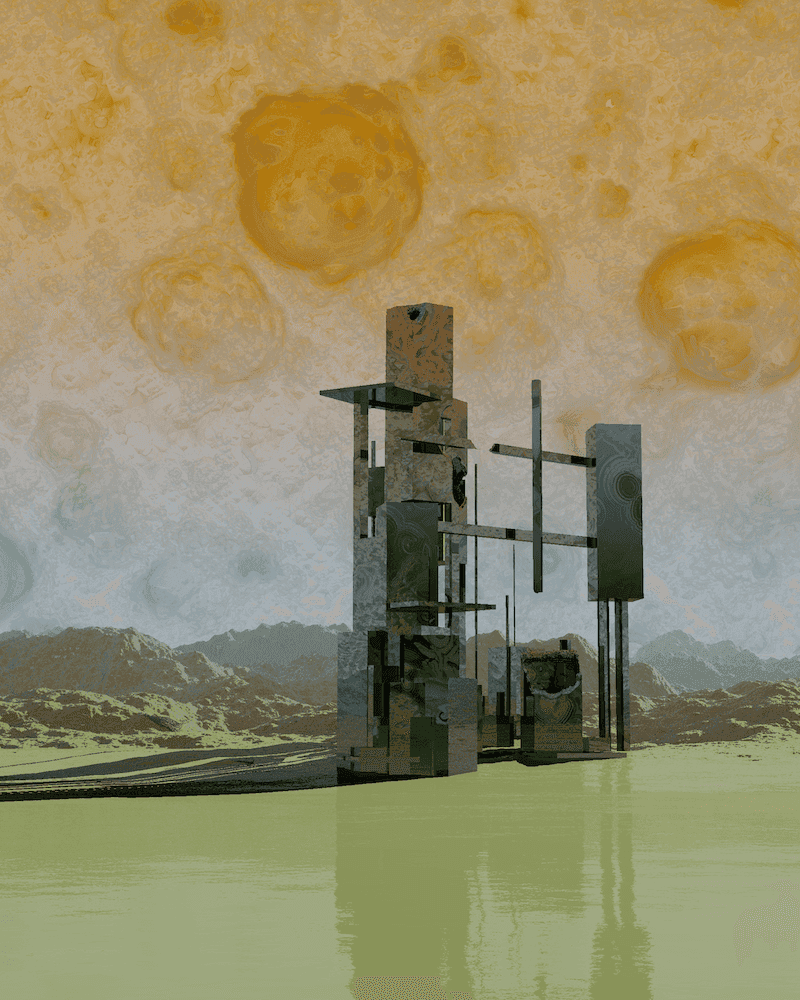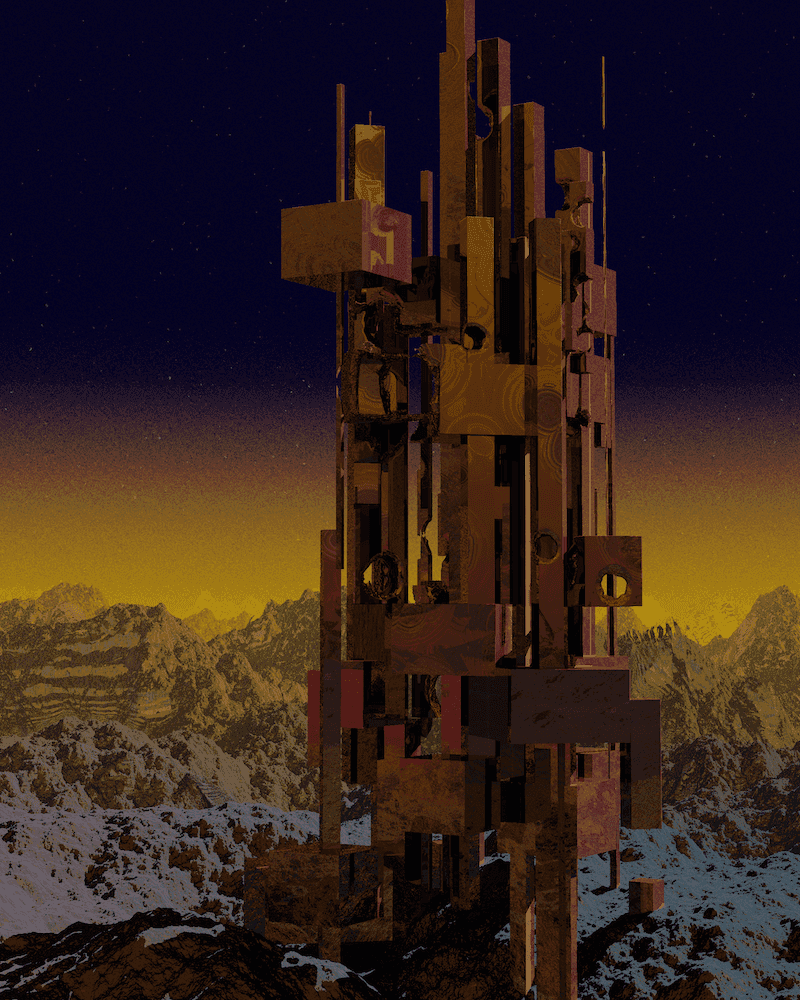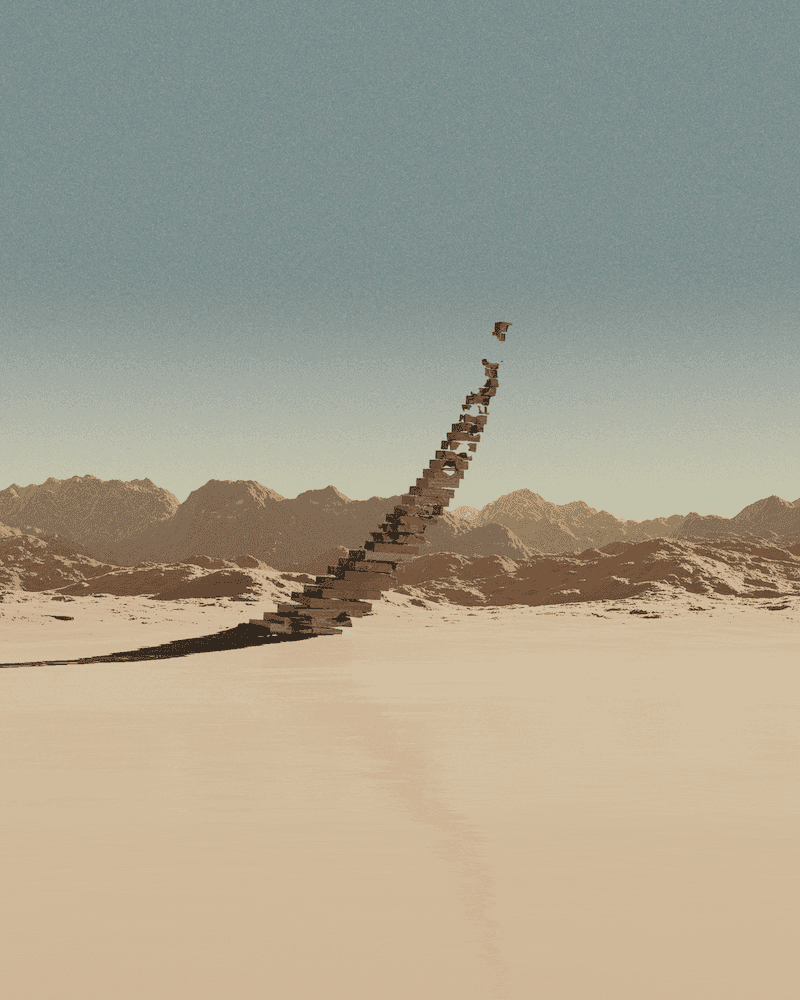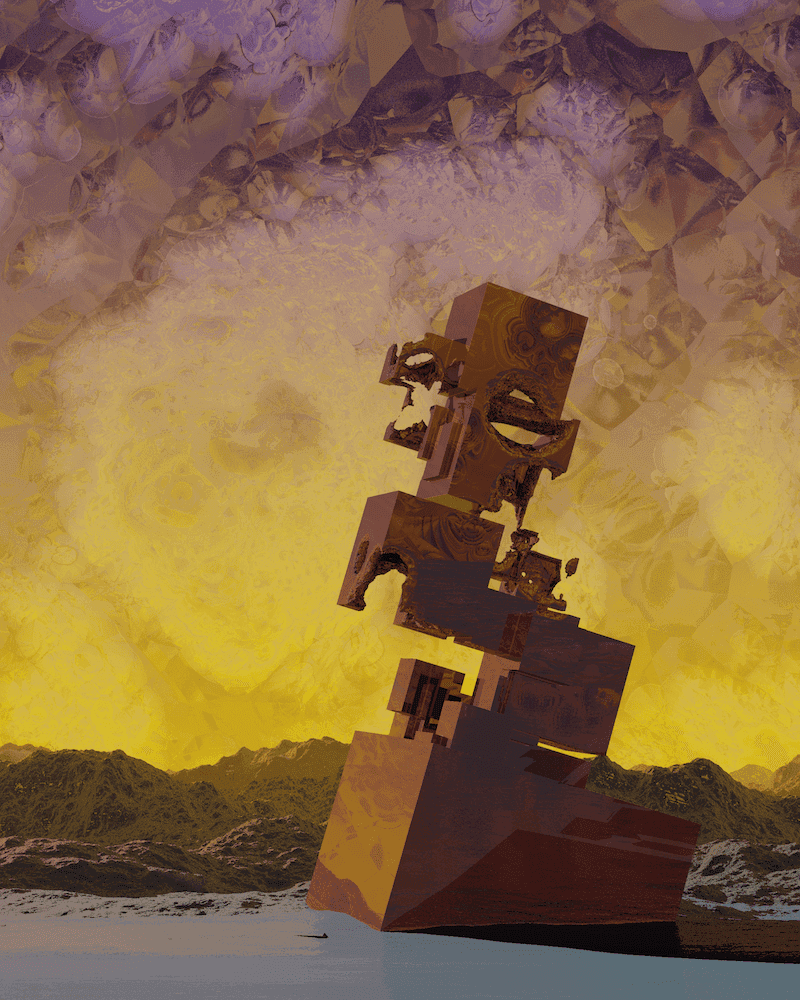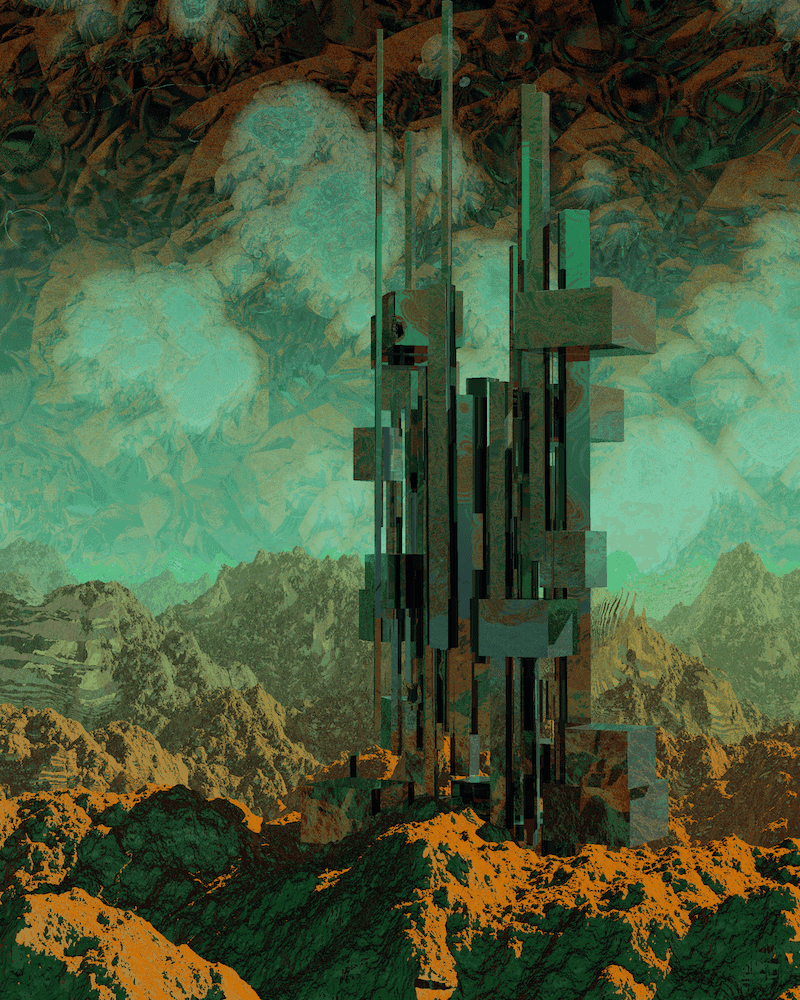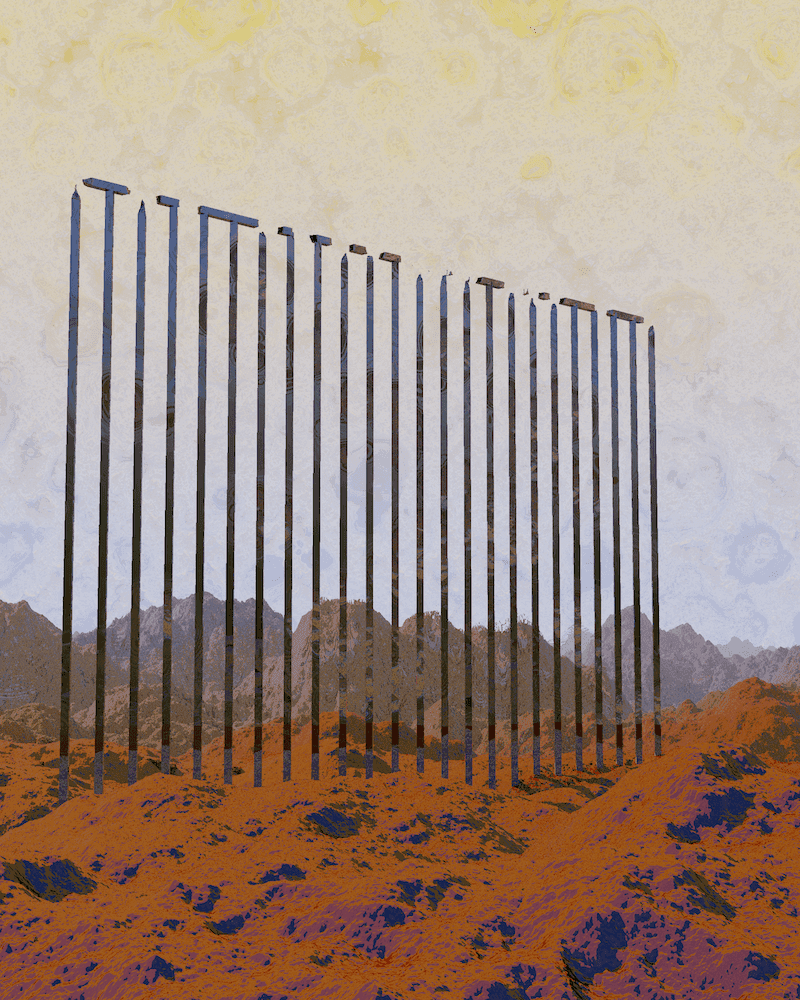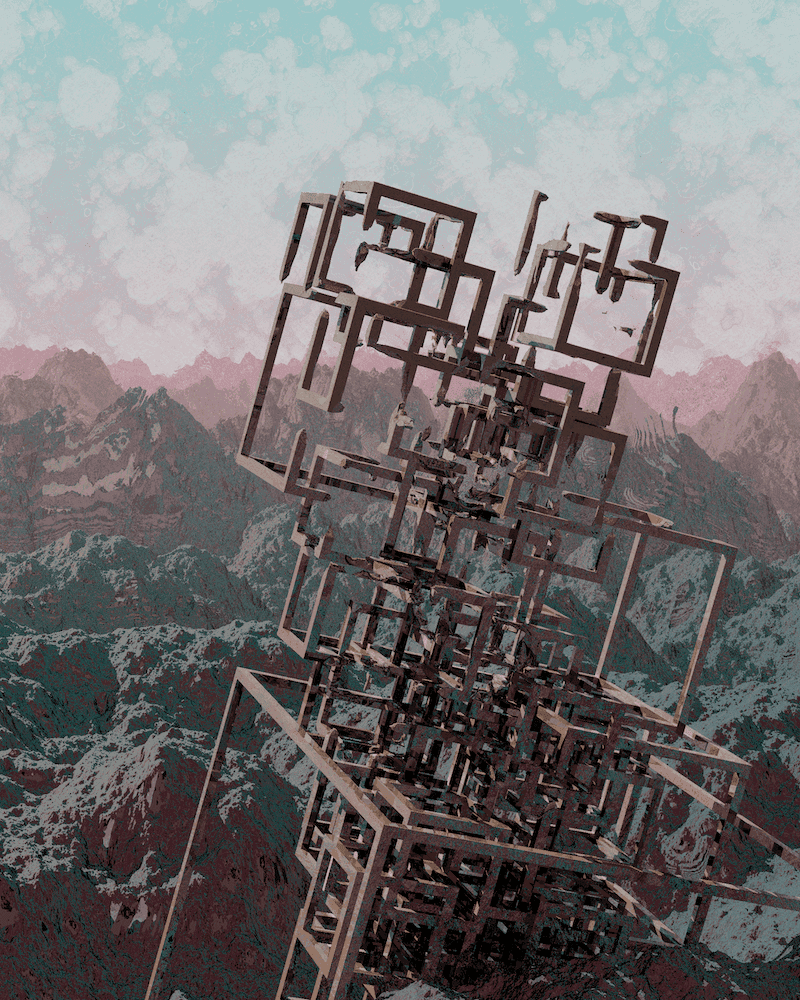Æons
Postcards from the End of Times
— By Dominikus Baur
Postcards from the End of Times
All this happens far beyond us, though. It's okay… we're still here: looking at pictures, dreaming of infinity, concocting our permanences. Building chains of blocks that will keep everything alive, forever, so we think.
This project is named Æons, for who can grasp more than a billion years? Let us just say that after every First follows a Last, and Æons anticipates the remnants of those final intelligent species in an indistinct future moment. Æons traces the entropy of our architectures of hope into hubris; the transit of meaning across an uncaring universe; the unimaginable scale of time and the vertigo induced when we try to imagine it.
Is this the time for aesthetics? The Romantics deemed it the Sublime: a pleasurable frisson of terror lighting up the body's boundary against boundless space. But there's only so much anyone can handle ofthat in one sitting, so let's keep it tranquil. In these vistas, the hustle and bustle is replaced with a serenity, a quietness. The algorithm relays towers stranded in deserts, in states of decay. Mountainous landscapes cradle the last vestiges of once great civilizations, whose stairs crumble under the tides of time. Look deep, and long. It could well be that no one is left at all; that all their striving is enshrined in these glass towers jutting defiantly skywards. Look on my works ye mighty and care…
The Loophole
My future is static / It's already had it / I could tuck you in / And we could talk about it.From Schizophrenia, Sonic Youth
The second law of thermodynamics allows only one direction for all order in the universe: towards chaos. Nothing static can endure; everything will turn to dust eventually. The only loopholes are processes: temporal patterns that keep themselves alive by repeating and adapting. Life is such a process, endlessly moving through the same cycles- birth, reproduction, death- but adapting with each repetition.
This project has a companion website, aeons.art, that stands sentinel, keeping track of the aliveness of the artworks. Static JPEGs will inevitably decay at some point (hard disks corrupt, computers succumb to obsoletion) but the JavaScript code for generating it - an instruction for a process - will remain on the blockchain with the potential to be run. It just needs a little help from outside- some willing finger to click on the 'Live View'- for the website to be informed that mint number x is still alive. No other information is required for this short message to be sent out to the internet. This Æons may thus survive a little longer, whilst others recede into the noise forever.
But there will come the day on which the last webbrowser will stop understanding JavaScript, garbling its instructed image into glitch and nonsense. A little later (or even before!), the artist Dominikus Baur will die together with his processing, and the unattended infrastructure of Æons.art will slowly fall apart, no longer recognizing incoming messages. One humid night, the last display to ever show an Æons will be switched off. Perhaps indolence will leave the drapes open, allowing this Æons' picture to be scorched into the latitudes as a decaying blip of light.
Imagining the Far Future
The inspiration for this piece sprang from the vertigo felt when contrasting one's brief lifespan with the immensity of geological time scales: contrasting all that we ascribe value to, with the indifference of the cosmos. Just look at the wikipedia entry, Timeline of the Far Future. We as people who live in a very short time span on this small planet… it's incredible that we are able to predict the events of such barely imaginable time scales. We are able to know roughly when the next supercontinent will rise up, when the sun swallows the Earth. We understand that the pull of entropy can only be resisted by processes such as life, and Æons portrays worlds in which all such processes have evidently ended. There's nothing left for its towers but to become one with the sand that surrounds them. Æons invites the viewer to contemplate astronomical time scales, notions of permanence set against inevitable decay, generative art as a process that resists entropy, and the hubris and loneliness of the artistic act. Perhaps as collectors and lovers of art, we play our part together to stave off that loneliness for a while.
Some artistic influences for Æons include Isaac Asimov's The Last Question: a classic short story on our place in the universe and the seeming inevitability of everything ending - whilst still hinting at ways out:, sources of hope. Tsutomu Nihei's Blame! is a Manga book which renders a sprawling cityscape of Brutalist architecture. Set, again, in an undisclosed future time, its protagonist avoids the killer robots the city harbours as massive buildings disappear into the fog. This inspired Æons' approach of letting pathetic fallacy and setting communicate meaning and tone. The video game, Babbdi, was a similarly bleak tonal influence; every person one meets in the town implores, 'you need to get out of here- it's a terrible place…just leave.' Van Trier's Melancholia takes this feeling of hopelessness to an extreme, its characters surrendering in the face of the apocalypse with the impending collision of a rogue planet. Perhaps this is one way to face the inevitability of dying: to resign, lay down and become forgotten. Simon Stålenhag's work is haunting and mysterious, combining a sense of banality contrasted with the perspective of looming robotic structures. And, of course, Shelley's Ozymandius casts a long, monolithic shadow when portraying the remnants and hubris of once-great civilisations.
Finally, the inspiration of French comic artist Moebius, particularly in his use of bright colour palettes, was important element in avoiding the collection becoming too dreary and oppressive. This is an allusion to 1970s utopian thinking: that the future is going to be awesome- a sort of Star Trek space-communism. That NASA would shuttle us to deeper reaches of the solar system and home again. Instead, of course, the space race stumbled into dystopian stagnation. To offset the monochrome of decrepit, lifeless towers, the formative influence of optimistic sci-fi anime such as Captain Future led to the adoption of intense and vibrant colour schemes, particularly in Æons' intense skies. The result is a melding of kitsch Seventies sci-fi realms and bleak realism. Here there's no sex; just dust. But at the same time there's been too much stelliferous beauty in the world for us not to acknowledge it.
Precursors
Hyperscopic, released on gen.art in July 2022, provides a parable which speaks to the core themes of Æons. Most artists and collectors in this space adhere to the narrative that blockchains will be online forever, preserved for eternity, and yet every other Web3 project ends after two years: its works condemned to irrelevance within a giant database. This year, Hyperscopic faced the threat of this premature obsolescence with the news of the deprecation of gen.art, emphasising how the societal and financial processes necessary to sustain forms of digital art can be just as prone to breakdown as celestial forms.
Dominikus is perhaps most widely-known for The Inner World, launched by Art Blocks in September 2022. This was the culmination of his js canvas-based work, drawing thousands of shapes which each had a drop shadow to create organic 3d sculptures.
Exeget in December '22 came after Dominikus had worked for a couple of years with javascript and canvas rendering and had to come to the end of his experiments with their possibilities. At this point, Piter Pasma's work on Art Blocks, Sculptuur, was inspirational, while Inigo Quilez's tutorials explained the way to raymarching- a process that can be implemented into whichever language, but fits well with shaders. Each Exeget output is raymarched- a three dimensional scene based on mathematical functions which simulates each light ray shooting from a camera into the scenes (whichever object the ray hits gets rendered). Dominikus worked on abstract -surrealistic, chthonic environments, and planned to include towers and landscapes. The original aim was to hone these into a longform project, but it proved too random and chaotic. So he instead chose 1/1s of some of the most visually rewarding corners of this mathematical universe.
Æons is the culmination of a year of work by Dominikus to bring that longform concept to fruition.
Render
All motifs in Æons are sculpted in math and all work in slightly different ways. The ground uses specific noise functions to simulate an organic landscape with plateaus that lead to distant mountains. Oftentimes, the ground also reflects nearby architecture, like a mirage. There are no lush jungles full of life; only arid mountains and deserts. There are bridges/ viaducts, and mysterious structures unaffected by gravity as if their creators saw themselves above even the laws of nature. They are all forms of boxes or cubes- a constraint which is also a play on the blockchain- designed to offset the rugged organic topography. Spheres crater the structures; a subtraction that cuts spheres out of the forms to suggest entropy.
Æons' stairs are emblematic of the whole project: they are stairs to nowhere, to the sky… but where are their people? Did they transcend, or fall? Grid-like columns may also form: either a plain grid - imposing order on an uncaring universe - or grids mimicking biological processes like the arrangement of seeds within a flower. Eccentric birdhouse-like shapes can form, where the algo places arches, picks corners to spawn new blocks, etc. The final form of edifice are towers which consist of cubes stacking randomly on top of each other, shrinking every step.
Finally, the sky - symbol of entropy, and the cosmos which weighs on the corner of the universe housing all those towers - is where the underlying math shines through the most. It veers wildly from calm skies, to puffy, friendly clouds, to apocalyptic cloudscapes, bathing the scenes underneath in various types of light. Dominikus allowed himself to leave a little of the randomness underlying all generative art in the piece - and here is where it shines through.
Æons is implemented in JavaScript and uses WebGL2 and a shader written in GLSL. A custom-written raymarching engine takes care of turning the mathematical scenes into pictures. Special care has been taken to find suitable placements and directions for the camera in the scene to create sometimes dramatic, sometimes soothing compositions. Reflections are a central aspect as ground, sky, and especially the structures, reflect the light of their surroundings - and sometimes even the happenings behind the virtual camera.
Traits
| Mountains | where do the mountains start, and whether plains are visible before them |
|---|---|
| Mirrorness | how reflective are surfaces in the scene |
| Framing | center|left|right |
| Lighting | side|back|front |
| Sky | simple|plain|heavy |
| Distance | how far away is the structure: near|mid|far |
| Structure | shifted|phyllo|barebones|fallenorder|cubes|march|stairs|mixed |
| Palette | 20 different palettes, aiming for various moods and levels of apocalypse |
| Wireframe | do we see cubes or wireframes |
Special Feature
Since Æons is based on a fully 3D environment, you can actually move around within the picture. However, be aware that no matter how far you travel around in the scene you won't find any aliens.
Controls
| A | move left |
|---|---|
| D | move right |
| W | move up |
| S | move down |
| look left, right, up and down | |
| P | zoom in |
| O | zoom out |
| C | download a copy of the currently visible image |
Since rendering takes a moment, feel free to press the same key multiple times to quickly change your perspective.
Æons allows multiple interpretations. What does it mean to exist if existence is finite? What does it mean for art, when meaning will die out one Thursday with the last star? Whilst this future does seem bleak, we offer you these postcards of our universe's last Æons of beauty. They will not be here indefinitely, but with a little luck, they may adorn your next few generations.
